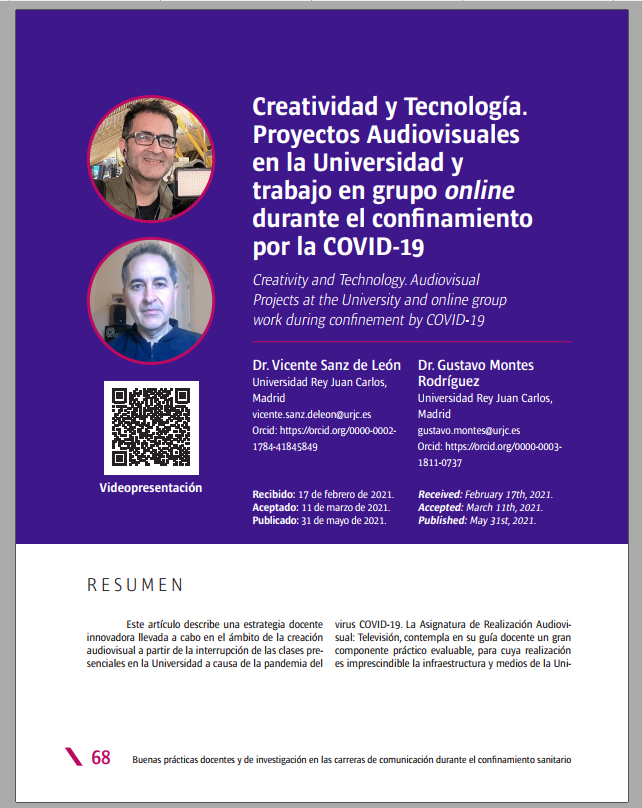Creativity and Technology. Audiovisual Projects at the University and online group work during confinement by COVID-19
Main Article Content
Abstract
This article describes an innovative teaching strategy carried out in the field of audiovisual creation after the interruption of face-to-face classes at the University due to the COVID-19 virus pandemic. The subject of Audiovisual Production: Television includes in its teaching guide a large practical component that can be assessed, for which the University’s infrastructure and resources are essential. To guarantee its delivery and evaluation, interrupted by the confinement, an original, creative and collaborative project was designed that takes advantage of the possibilities offered by ICT. The project is based on a script developed collectively through the Exquisite Corpse game. The follow-up, the elaboration of a questionnaire and the results of the creation, allow us to conclude that the design of this project has contributed to improve the handling of the editing tools, to develop the creativity of the students, as well as their involvement and motivation, in addition to having implemented the dynamics of group work through the internet.
Article Details
References
Area, M. (2010). “¿Por qué formar en competencias informacionales y digitales en la educación superior?” RUSC.
Revista de Universidad y Sociedad del Conocimiento, 7(2), 3. Disponible en https://bit.ly/2ROBd55
Barthes, R. (1990). La aventura semiológica. Barcelona, España. Paidós.
Barroso, J. (1996). Realización de los Géneros Televisivos. Madrid, España. Comunicación Audiovisual.
Cea D´Ancona, M. A. (1998). Metodología Cuantitativa. Estrategias y técnicas de investigación social. Madrid, España. Síntesis Sociología.
Costa, J. (28 de abril de 2016). La utopía fabulada. El país. https://elpais.com/cultura/2016/04/28/actualidad/1461844696_058302.html
De Miguel, R. (2005). “La observación sistemática y participante como herramienta de análisis de los fenómenos comunicativos”. En Berganza, M. A y Ruiz, J. A. Investigar en comunicación. (p. 279) Madrid, España: Mc Graw Hill.
Figueras-Maz, M., Ferrés, J. y Mateus, J.C. (2018). “Percepción de los/as coordinadores/as de la innovación docente en las universidades españolas sobre el uso de dispositivos móviles en el aula”. Revista Prisma Social, (20), 162. Disponible en https://bit.ly/2psvnGw
Sancho, E., y Moral, E., (2020). La ventana de mi habitación. https://drive.google.com/file/d/1RG1y9m6FFu406qMBCoEKQVUPSNQ-xLYx/view?usp=sharing
Brandariz, A., y Balán, A., (2020). Biberones, tetas y profetas. https://drive.google.com/file/d/127LpQTJcaYlf37vb6s2t2VwqVyXxETky/view?usp=sharing
Fernández-Pacheco, T, (2020). Deleite Confinado. https://drive.google.com/file/d/1z2NDI3eAKfPm6R7sT2P6bxnjnCTDor41/view?usp=sharing
López, L. (2018). “Metodología aprendizaje basado en proyectos (ABP)”. Didactia. Disponible en https://didactia.grupomasterd.es/blog/numero-12/metodologia-aprendizaje-basado-en-proyectos-abp
Marqués, P. (2013). “Nuevas metodologías docentes para mejorar la formación y los resultados académicos de los estudiantes”. Padres y Maestros. (21)351, 16-21.
Moreno, I. (2002). Musas y nuevas tecnologías. El relato hipermedia. Madrid, España. Paidós.
(RTVE. 30-09-2016). https://www.rtve.es/alacarta/videos/dias-decine/spain-in-day/3739675/).
Sanz, V. (2016) Videoclip El Lobo. https://www.youtube.com/watch?v=A5x89qcH39U
Sito. https://www.sito.org/


